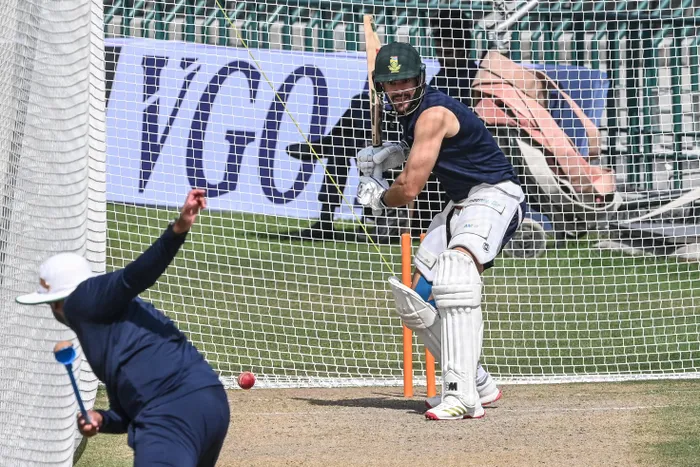COMMENT | Do modern-day batters have the defence and patience needed in Test cricket?
PROTEAS TOUR TO INDIA

Proteas stand-in captain Aiden Markram faces a few throw downs in the nets ahead of the second Test against Pakistan. Picture: AFP
Image: AFP
In the wake of the low-scoring contest in the first Test match between India and South Africa at Eden Gardens in Kolkata last week, questions have been posed about the modern-day batters’ techniques.
If there ever were conditions that would test a batter’s technique, it is the subcontinent conditions, and the Indian conditions in particular.
From the very first day of the first Test in Kolkata last week, it was clear that spin would play a massive role as India spinner Axar Patel was brought on to bowl inside the opening eight overs of the Test.
There was also a variable bounce in the wicket, making it very difficult for the batters to trust the bounce, particularly against the fast bowlers.
The combination of spin and variable bounce made the batters’ lives very difficult.
As a result, despite South Africa registering a historic victory in India, their first Test victory in 15 years in India, neither of the two teams passed the 200-run mark during the first Test, with the highest total being India’s 189 in the first innings.
Only the Proteas captain, Temba Bavuma, was able to cross the half-century mark, as he put together a 136-ball 55 not out, while all the other batters struggled in what was a tough pitch to bat on.
Bavuma put on a masterclass on the importance of having a solid defence in Test cricket and displayed great patience as he laid the foundation for the Proteas’ victory.
On the other hand, the rest of the batters from both teams struggled. Perhaps what was shocking to witness was the poor shot selection and the lack of patience displayed by the batters in a format that demands patience from the batters.
Kyle Verreynne’s attempted sweep shot in the second innings is a prime example. South Africa were on 60/5 when Verreynne walked in to bat, and South Africa only had a 30-run lead.
However, the wicket-keeper batter went for a booming sweep shot, one that led to his dismissal, leaving the team in a deeper hole with the score on 75/6.
Despite the nature of the wicket, the nature of the wicket made the shot selection questionable, as the Proteas needed Verreynne to occupy the crease more than anything.
It is important to acknowledge that Test cricket has evolved over the years, and the ‘positive’ approach is what coaches tend to encourage from the batters.
However, the fundamentals of Test cricket still remain, and the surface at Eden Gardens demanded that the batters exercise them. Instead, most of the batters showed very limited patience and seemed eager to feel bat on ball.
Bavuma’s innings showed that one could score runs despite the challenges the wicket at Eden Gardens presented.
Perhaps it is also important to note that Bavuma is one of the few batters who played that Test who does not play much T20 cricket lately.
Could this have played a hand in him being the only successful batter on that wicket?
Even in the India camp, Rishabh Pant's dismissal against Proteas spinner Simon Harmer in the second innings could have been avoided.
Standing in as captain in the absence of Shubman Gill, who was out due to a neck spasm, India needed Pant to play a more responsible innings.
Instead, the left-handed batter went down the wicket, looking to hit Harmer down the ground for a boundary, and could only hit it straight to Harmer, who took the catch.
That decision basically handed South Africa the victory. It seems that the modern-day batters lack the patience needed in Test match cricket.
Related Topics: